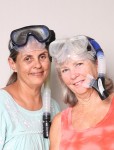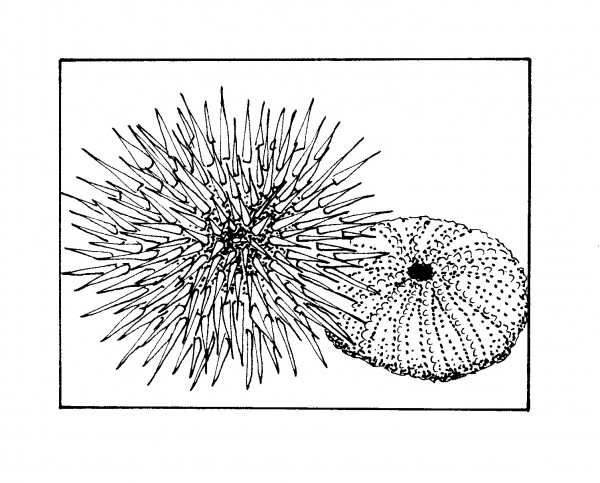Peeping at a Prickly, Purple Pincushion

Who would suspect that a prickly, purple pincushion looking thing we see on the rocks would hide a beautiful pale green shell that we find rolling in the waves? This is the test (external skeleton) of the purple sea urchin (Strongylocentrotus purpuratus) that remains after its death. The animal is an echinoderm, Greek for echinos-spiny and derma-skin and belongs to a large group of marine animals that include sea stars, sand dollars and sea cucumbers. Urchins are radially symmetrical with five joined body plates forming a round test arranged around a central axis. The test is covered with sharp deep-purple colored spines that stick out in all directions that are used for defense, locomotion and feeding. Interspersed between the spines are stinging pedicellariae, small pinching appendages which are used for defense, locomotion and cleaning. In addition, there are hundreds of barely visible tube feet ending in suckers, which are used for feeding, locomotion and respiration. Recent studies indicate that the tube feet are the location of large numbers photoreceptors, which give them limited vision. They have no brain.

The purple sea urchin resembles a four-inch wide pincushion. The underside of the urchin contains a beak-like mouth, called Aristotle’s lantern, made up of five toothed plates. Waste is excreted from the hole in the top. Estimated to live over 70 years, the range of the purple sea urchin is along the Pacific Ocean from Alaska to Baja California. Located in the low tide surf zone of the rocks down to over 500 feet deep, this nighttime grazer tends to live near its favorite food source, the giant kelp (Macrocystis pyrifera). In the past, the kelp beds became overrun with urchins creating barrens that prevent kelp from reestablishing. At that point, the urchins will forage on other types of algae, chitons and other marine species.
The purple sea urchin is dioecious, either male or female, and reproduces by broadcast spawning. In January through March of the year, females release millions of eggs and males release sperm into the current where once fertilized, they drift as larvae for two to three months before landing and developing the characteristic urchin shape. Their growth is highly dependent on food availability. Predators include sea otters, lobsters, sheephead and sunflower sea stars. When a predator makes contact, the urchin immediately points its spines in that direction. Historically eaten by the California indigenous peoples and currently a delicacy in Asia, there does not exist a commercial fishery for the purple sea urchins because of the small yield and the expense of processing.
Increasingly studied because recent genetic discoveries have shown that humans and urchins have over 7000 genes in common, thus making them closer to man from an evolutionary perspective than many other animals. Active research is being done in many areas including: genes common to both urchins and humans that are related to many cancers, diabetes, Alzheimer’s disease, Parkinson’s disease, Huntington’s disease and muscular dystrophy. The immune system of the animal is also being investigated, because unlike humans who have both innate immunity and acquired immunity, the urchin only has a very well developed innate immunity but with 10 to 20 times as many immunity genes as humans. Urchin research may lead to preventing and curing many human diseases. The homing ability of the urchin’s sperm for egg fertilization is being examined with the hope of solving human reproductive problems. In addition, the ability of the urchin to control the elasticity of its body has several repercussions for our pursuit of maintaining a youthful appearance.
Due to a depletion of its natural predators, the increase of marine pollution and runoff causing an abundance of algae, a main food source, urchin populations have increased to the point that they have become a dominant species in Laguna Beach. The purple sea urchin is an important part of a healthy marine ecosystem, both as a major food source for several key species and as a way of limiting and controlling an area from becoming overrun with kelp. Easily found when you visit the tidepools, enjoy gently and safely. All of Laguna Beach is a marine protected area and there is no collecting of animals and shells.
Residents and year-round ocean swimmers, Mia Davidson and artist Jan Sattler are dedicated to fostering stewardship of Laguna’s coastal ecosystems.




